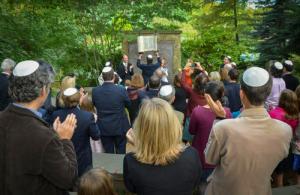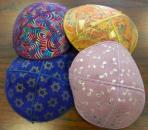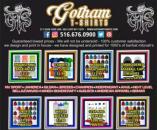
I knew the routine well. After all, I had been a Bar/Bat Mitzvah tutor at the same reform synagogue for well over a decade. There was an expected protocol for preparation, and the services themselves were always conducted in a very familiar order with well-rehearsed choreography. Often families would ask, “How can we make the service feel uniquely special to our family?” Of course, there is something beautiful and comforting about the traditional customs and rituals of a temple community. Synagogue clergy will often encourage that any ‘customized ideas’ be relegated to a post-service celebration rather than during the service itself. However, there are ways to respectfully complement a ceremony with symbolic touches that will make the Bar/Bat Mitzvah experience all the more meaningful and memorable.
Each temple community has its own set of expectations for the Bar or Bat Mitzvah, and it is of utmost importance to respect the customs of your congregation. When you schedule your first meeting with the rabbi or ritual director, feel out how much latitude you have in changing or augmenting any aspects of the ceremony, especially if you want to give out “parts” to family members. If you’ve attended other services outside of your own synagogue, be prepared to share which rituals or moments resonated with you most and why you want it for your daughter or son’s moment on the bimah.
SHABBAT & BEYOND
Nowhere is it written, “Thou shalt only have a Bar or Bat Mitzvah service on a Saturday morning followed by a catered Kiddush luncheon.” However, you really do need to check in with the temple administrators about what kind of flexibility you have with the days and times. If there is openness to dates outside of a Saturday morning, there will be significant changes to the service length and content.
Some families opt for a Shabbat Mincha (Saturday afternoon) or Shabbat Ma’ariv (evening) service, the latter of which concludes with Havdalah, a ritually-rich ceremony complemented by lovely sung prayers that marks the end of Shabbat and the beginning of a new secular week.
However, keep in mind that Shabbat ends with sundown, which will fall much later in the evening hours of early fall and late spring, affecting the timing of Havdalah. Typically, both the mincha and ma’ariv services, which may include a Torah service, are much shorter than a regular Shabbat morning service, which includes more extensive prayers and both Torah and Haftarah readings. Of course, you can hold a service that doesn’t fall on Shabbat at all. Many families opt for Sundays or a weekday, especially if family members are Shomrei Shabbat (strict adherents of the Sabbath) and cannot drive to your celebration on a Saturday. Each of the services offers different prayer components, so it will be important to review with your rabbi or service leader what’s expected of the Bar/Bat Mitzvah if you have the option for a morning, afternoon or evening service, Shabbat or otherwise.
Bar and Bat Mitzvah ceremonies combined with the holidays allow for interesting ways to get creative and engage more family members. Last fall, I attended a Sunday service, which also happened to be the seventh day of Sukkot known as Hoshanah Rabah. The family’s rabbi suggested this festive occasion not only because it is resplendent in the colors and fragrances of the autumn harvest, it also happens to offer a shorter Torah reading. Together the rabbi and the family determined this would be better suited to the abilities of the Bar Mitzvah boy. The guests gathered in celebration, shaking the lulav and etrog, under the sukkah which was constructed with help from the family, making this occasion all the more spiritually significant.
RITUAL OBJECTS
It is customary at most temples for the Bar or Bat Mitzvah child to wear a tallit (prayer shawl). If you have a tallit for presentation, perhaps explain the significance of the ritual item and the importance of how it came into the family. The same could be true for a kippah (prayer cap) or a yad (pointer) used for reading the Torah. In some cases, a congregation will hold a Kiddush on the bimah immediately following a service. Is there a family Kiddush cup or challah cover that can be presented as part of the prayers over the wine and bread? If you have a celebration during Chanukah, include your family’s menorah and invite family to kindle the holiday lights.
“I think personalization is wonderful, and the service needs to speak to our unique hearts and life experiences,” said Evan Moffic, a rabbi at a temple in the northern suburbs of Chicago. He embraces discussion about what families have observed at other services, and has often included rituals that strike a meaningful chord with families. “There have been a dozen occasions where we even used a Torah that has been part of the family. It makes the service quite special.”
GIVING HONORS
While an heirloom Torah is certainly a rarity, it is a visual splendor to watch a Torah be passed down l’dor va’dor (from generation to generation) in front of the open ark. At a reconstructionist service I attended, great grandparents, grandparents and parents stood alongside their Bar Mitzvah facing the congregation. As the rabbi explained the significance of the ancestral promise to carry on the tradition of teaching the commandments onto children, the family stood shoulder-to-shoulder, ready to ceremonially pass the Torah from the eldest to youngest. The congregation stood mesmerized by the jingling of the silver ornaments that adorned the sacred scrolls as the Torah gently made its way into the arms of the Bar Mitzvah, who then brought it to the podium in preparation for reading. There are many other ways to offer up honors, known as kibbudim, to family members and close friends at your service, regardless of their faith.
“We included as many family members as possible, to involve and honor them,” recounted Ashley, the mother of a Bar Mitzvah boy from a conservative temple in Morris County, New Jersey. “My mother presented the tallis with a beautiful tribute to my son. His great aunt and uncle opened the ark. Aliyot [Torah blessings] were given by his Jewish uncles and cousin. English readings were read by family members who were not Jewish, since we are an interfaith family. It all culminated into a very personal, touching service.”
Ask your rabbi about other ways to offer kibbudim. For younger children, consider several invitations to open and close the ark, or the honor of holding the Torah crowns and ornaments for safekeeping during the Torah service. If it’s customary at your temple, they also could join in the parading of the Torah scrolls around the synagogue. After the Bar or Bat Mitzvah child has read from the Torah, Jewish adults may have the opportunity to conduct the hagbah, or the lifting of the open scrolls to reveal what had just been read to the entire congregation, and the gelilah, which involves rolling up, binding and dressing the Torah for its proper return to the ark.
Cantor Barbra Lieberstein Fergang serves students in both Rockland County, New York and Bergen County in New Jersey, and has a plethora of ideas to make services feel more personalized for families, whether in a congregational setting or outside of a synagogue environment. She suggests honoring immediate family members and if applicable, the Bar/Bat Mitzvah’s tutor, during the reciting or chanting of the threefold priestly benediction. “The parents, siblings and the tutor hold a tallit like a chuppah above the child signifying a shelter of peace and protection,” explained Cantor Barbra, making this a poignant moment for those closest to preparing the service. You could also consider raising the tallit as a chuppah during a parents’ blessing.
YOUR UNIQUE FAMILY
The leadership at the Bar or Bat Mitzvah service in and of itself is a unique contribution. Michael Sternfield, a rabbi based out of Bradenton, Florida, encourages the B’nai Mitzvah to conduct as much of the service as possible. And then there’s the much anticipated d’var Torah (aka “The Speech”) where your child is expected to draw relevance from the Torah portion to one’s life. Rabbi Sternfield guides his students to take on Mitzvah Projects that have an emphasis on the interpersonal human experience, so that they can speak from the heart about the ethical gains they have made as part of this Jewish rite of passage. And as for the parents’ remarks that add another distinct element to every service? The rabbi advises, “Remember, this is not the Academy Awards. It’s not about how great a soccer player you have or about the merit badges that your kid earned or the grades he or she gets at school. This is your opportunity to talk about the spiritual meaning of the occasion and how the entire experience has represented your family’s values.”
Indeed, family is at the heart of what makes a ceremony different from anyone else’s. Mazel tov and best wishes in making yours especially memorable for your loving mishpucha.
QUESTIONS TO ASK YOUR CLERGY
Advice on questions to ask clergy as you explore ways to personalize your Bar/Bat Mitzvah ceremony:
• What makes the service unique or different from other synagogues or clergy?
• How can we adapt the service to my child who has special needs?
• How can we include non-Jewish family members to make the service all-inclusive?
• How can we include all immediate family members to make the ceremony more meaningful?
By Cara J. Moroze





